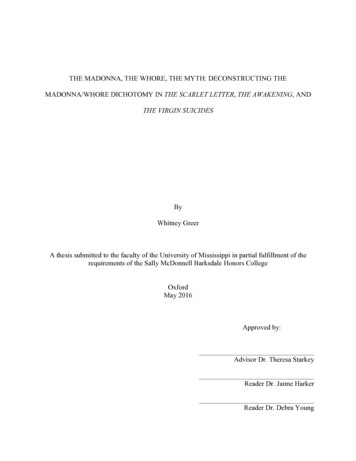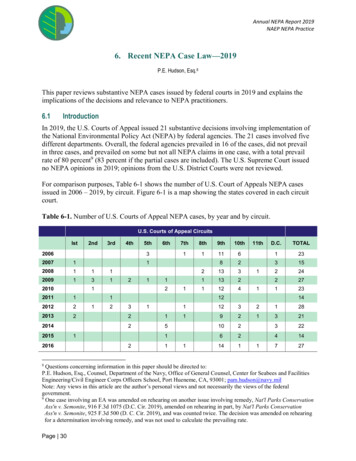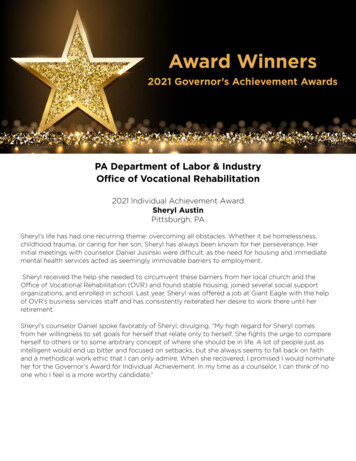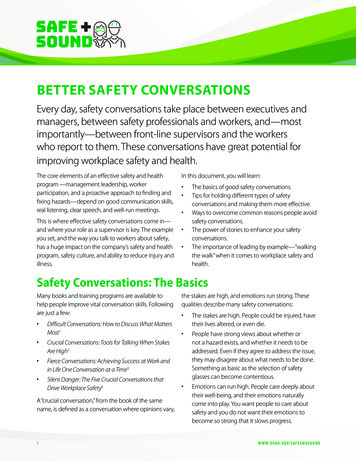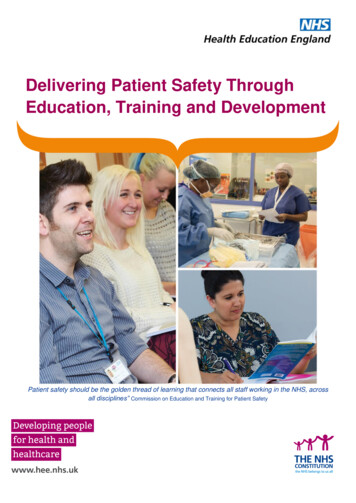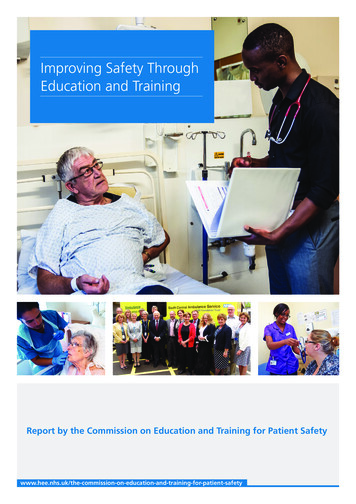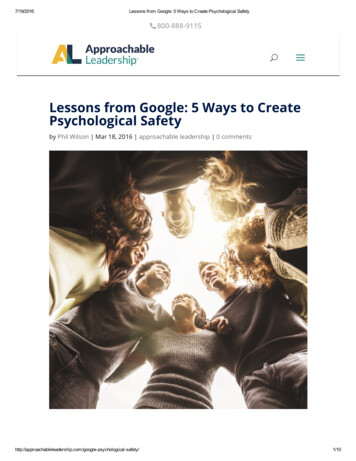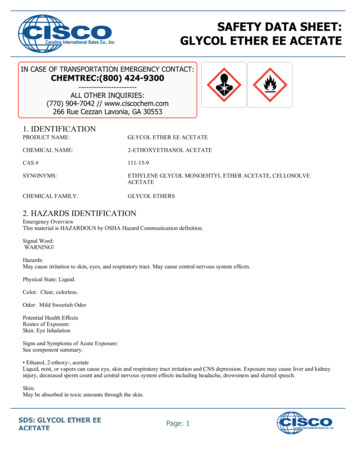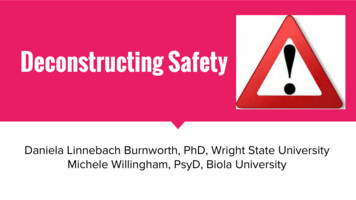
Transcription
Deconstructing SafetyDaniela Linnebach Burnworth, PhD, Wright State UniversityMichele Willingham, PsyD, Biola University
Learning Objectives Participants will be able to identify at least 3 commonexpectations for safety in training contexts, includingsupervision. Participants will be able to name at least 2 potentialbarriers to effective training and supervision posedby the assumption of “safety.” Participants will gain at least 2 examples of activitiesand/or strategies for deconstructing safety with theirinterns and reconstructing expectations for selfreflection and engagement in courageous conversations.
Opening ActivityAs we approach this time of learningtogether, please consider the followingquestions with 1 or 2 colleagues sittingnear you and be prepared to sharesome of your thoughts with the group.When it comes to clinical training and supervision What is “safety?” What elements are necessary for a learning/trainingenvironment to feel “safe?”
Notes from Activity - What is Safety?Respect, Being heard, Developmental in natureSeparate ideas from the person,Relationships as the foundationNot necessarily comfortableA “firm” container; stability“Good enough” participant ideaReceptivity, OpennessSupport/challengeNo judgment, Accepted
Safety in Training & Supervision:Definitions & Expectations Strong supervisory alliance positiverelationship, characterized by mutual trust,liking, and a strong emotional bond (Bordin, 1983) Related to a “supervisee’s perceived safety,trust and alliance” (Wong, Wong & Ishiyama, 2013) Facilitates an open supervisory climate where the superviseecan be vulnerable and take risks Unspoken social processes, power differentials, and racialdynamics, can cause interns to feel a lack of trust andpsychological safety
Safety in Training & Supervision:Definitions & Expectations Multiculturally competent supervisors are ‘‘crucial catalysts’’ infacilitating interns’ awareness of racial and cultural issues.(Proctor & Rogers, 2013) Explicit conversations about power, privilege, oppression, andthe dynamics of the supervision relationship can create‘‘liberating training spaces’’ for interns. Supervisors “make the invisible visible” by encouraging internsto consider their underlying cultural assumptions and blindspots, to challenge their biases, and to ask awkward questionsrather than be silent.
Safety in Training & Supervision:Definitions & Expectations Mentoring “intensive caring” “What sets mentoring apart is that the focusis on how supervisees are treated rather thanon how they are trained.” (Wong, Wong & Ishiyama, 2013) Supervisors mentor when they willingly serve as role modelsbeyond formal supervision responsibilities Empathy, genuineness, and openness to feedback about their ownstyle of relating builds a climate of personal safety and trust These conditions can give supervisees a voice and facilitateself-evaluation and self-actualization.
Another ActivityLet’s consider another aspect of thisconversation. When it comes to clinicaltraining and supervision How do we define “comfort” and“discomfort?” What elements are necessary for a learning/trainingenvironment to feel “comfortable?” What can make a learning/training environment feel“uncomfortable?”
Notes from Activity - What is Comfort?Radical acceptance / tolerance“screw up please”Getting a “pass”Finding the “sweet spot”Difference between discomfort and painA little “danger” is necessaryI’m not perfect – “Wow, that was messed up, huh?”Metaphors for intern being in control of what’sshared, e.g. “can I help you with your coat?”
Barriers to Training & Supervision Safety, when it becomes synonymouswith comfort, begs the question: “What can we actually promisewithin a training setting?” “Or, within a supervision relationship?” Is our framework for approaching the situation congruentwith our intended outcome? Who is asking to be safe?
Barriers to Training & Supervision Training and supervision contexts are challenged by thefalse security of “safety,” resulting in:Pulling back from the challenge.Getting “stuck” in the privilege.Limiting the learning that can occur.Compounding injury.Identifying challenges to ideas/beliefs as personalattacks. (Arao & Clemens, 2013) Expressions that these dynamics “shouldn’t happen” inlearning environments. (Redmond, 2010)
Barriers to Training & Supervision
Barriers to Training & Supervision
Barriers to Training & Supervision “Safety” may give the illusion of protection from evaluation,judgment, challenge, acknowledging mistakes and beingheld accountable.
Barriers to Training & Supervision Relational safety does not equal blind validation orunequivocal emotional support.(Hernandez & Rankin, 2008; Hernandez & McDowell, 2010)
Strategies for Deconstructing Safety Relational safety refers to developing critical thinking skillsin a caring environment. Not a result of discreteevents, it evolves overtime through dialogueand reflection. Not always relationallyor emotionallycomfortable.(Hernandez & Rankin, 2008;Hernandez & McDowell, 2010)
Strategies for Deconstructing Safety Establishing rules for community engagement. Remember that we do not intend to harm one another We all are participants in a process involving mutual comfortand discomfort. An ongoing dialogue inwhich we articulate ideas,raise questions,challenge points of view,ponder issues, andexpress concerns(Hernandez & Rankin, 2008;Hernandez & McDowell, 2010)
Strategies for Deconstructing Safety Transparency early in the process and repeatedthroughout. Brave spaces (Arao & Clemens, 2013) Calling in (Tran, 2013) Building a sense of belonging and valuewithin the group or supervisory relationship(Emerson, 1996). Finding points of overlap Modeling and engaging as the facilitator Addressing issues of silence and silencing
Strategies for Deconstructing Safety PROCESS ParticipateRespectOpennessCivilityEmpathySeek to understand othersSelf-care
Strategies for Deconstructing Safety Other ideas? Your experiences?
Group Brainstorm on Deconstructing Safety w/InternsWe all use a variety of metaphorsWe don’t talk about “safe sex,” we talk about “safersex.”We don’t talk about this being a “safe environment” wetalk about this being “a learning environment.”Tell interns they are going to “get woke” and invitethem to share their “awake moments”Acknowledge the larger systems in which we exist, andwhat may be modeled or not. Our staff are some of thebest models of what not to do.
Group Brainstorm on Deconstructing Safety w/InternsSuggest to interns that as emerging professional, theywill witness various ways of behaving, and they canchoose what to incorporate into their own professionalidentity and what they will use to “line the birdcage.”Talk about Intent vs. Impact, when we accidentally hurtsomeone, whether we intended to or not, we apologize(example of stepping on someone’s foot).Talk about the virtues of Curiosity – “I wonder?” andHumility – “I don’t know” in both training and therapy.
Group Brainstorm on Deconstructing Safety w/InternsWhen interns get entrenched? Point out that they mightbe trying to paddle to the island of agreement ratherthan the island of understanding, and as trainers/thecaptain, it is our job to help them paddle to theright island.Examine from a clinical perspective, too – if this iswhat we do with each other, what do we do withclients? Supervisees? Ask, if this was your client,how would you navigate this?We can respect the person’s right to have an opinioneven if we may not respect the opinion itself.
Group Brainstorm on Deconstructing Safety w/Interns“I may not respect your opinion, but I understand itis important to you.”Do our interns have the cognitive flexibility to havestrong feelings without imposing those feelings ontosomeone else or allowing others to have their ownstrong feelings?We need to expect and accept non-closure, closure isoften a mythPractice self-compassion and radical acceptance forour own internalized stuff.
Group Brainstorm on Deconstructing Safety w/InternsTrainers need to show transparency, model and talkabout the nature of social justice work, about aspectsof power dynamics and politics, choosing battles andvoice how we show up differently in differentcontexts.Ask our interns to “go to wherever your edge is,” toalways do your best, stay engaged, talk aboutdiscomfort, speak your truth, say “ouch, that hurtme.”
References Arao, B. & Clemens, K. (2013).From safe spaces to brave spaces: A new way to frame dialoguearound diversity and social justice. In The Art of Effective Facilitation.Stylus Publishing: Washington, DC. Ellis, M.V., Berger, L., Hanus, A.E., Ayala, E.E., Swords, B.A. & Siembor,M. (2014) Inadequate and Harmful Clinical Supervision. The CounselingPsychologist, 42:4, 434–472 Emerson, S. (1996). Creating a safe place for growth in supervision.Contemporary Family Therapy, 18, 393-403.
References Hernandez, P. & McDowell T. (2010). Intersectionality,Power, and Relational Safety in Context: Key Concepts inClinical Supervision Training and Education in ProfessionalPsychology, 4:1, 29–35. Hernandez, P. & Rankin IV, P. (2008). Relational safety and liberatingtraining spaces: An application with a focus on sexual orientationissues. Journal of Marital and Family Therapy, 34, 251-264. Hill, H.R.M., Crowe, T.P. & Gonsalvez, C.J. (2016) Reflective dialogue inclinical supervision. Psychotherapy Research, 26:3, 263-278.
References Ngọc Loan Trần (2013). Calling in: A lessdisposable way of holding each other e/ Proctor, S.L. & Rogers, M.R. (2013) Making the Invisible Visible:Understanding Social Processes Within Multicultural InternshipSupervision. National Association of School Psychologists Forum:Research in Practice, 7:1, 1-12.
References Redmond, M. (2010). Safe space oddity:Revisiting critical pedagogy. Journal of Teachingin Social Work, 30, 1-14. Wong, L.C.J., Wong, P.T.P., & Ishiyama, F.I. (2013) What Helps and WhatHinders in Cross-Cultural Clinical Supervision. The CounselingPsychologist, 41:1, 66-85.
Michele Willingham, PsyD, Biola University Deconstructing Safety. Learning Objectives Participants will be able to identify at least 3 common expectations for safety in training contexts, including supervision. Participants will be able to name at least 2 potential
